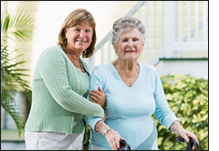Dressing Strategies for Seniors with Physical, Visual or Cognitive Impairment
Our top priority at Visiting Angels Oshkosh is to maintain the dignity of our clients when providing in-home care services. Some of our personal care services can be delicate, such as dressing, bathing, and hygiene assistance. Therefore, we work tirelessly to refine our skills to make these services the most thorough yet modest, so we build trust and maintain the comfort of our senior clients. Also, we strive to help our clients be as independent as possible when performing activities of daily living by encouraging them to complete as much of the task as possible.
Therefore, we work tirelessly to refine our skills to make these services the most thorough yet modest, so we build trust and maintain the comfort of our senior clients. Also, we strive to help our clients be as independent as possible when performing activities of daily living by encouraging them to complete as much of the task as possible. For many seniors, physical, visual, or cognitive impairments can get in the way of independently completing dressing routines at home. For example:
- Strokes can cause significant motor impairment in one arm or leg and visual changes.
- The tremors associated with Parkinson’s may prevent the ability to button buttons, tie shoelaces, buckle belts, or zip zippers.
- Recent shoulder surgery or severe arthritis may restrict seniors’ ability to lift their hands over their heads to put on a pullover shirt.
- Alzheimer’s dementia may cause confusion between the left shoe and the right and confusion with visual-spatial abilities required to put on a shirt or pants correctly.
- Hip and knee replacement patients have difficulty bending to reach their feet after surgery.
Upper Body
Tip #1: Pullover Shirt
- When dressing with a pullover shirt, if one arm is affected by surgery, pain, or disability, dress that arm first, next dress the stronger arm, then feed the head through the top of the shirt last. When removing a shirt, the order is reversed. Undress the stronger arm first, the affected arm next, then remove the head from the shirt last. If a client is having difficulty determining the back versus the front of a shirt, a small tag or label indicating the back of the shirt can be helpful.
-
When dressing with a button-up shirt, dress the affected arm first, then dress the stronger arm second.
When undressing, the reverse is also true here. Remove clothing from the stronger arm first and the affected arm next.
Explore the use of a button hook to promote independence with buttoning buttons. Small hooks or zipper pulls are available to make zipping tasks easier.
-
When putting on a bra, first clasp it in the front, next rotate the buckle to the back, then put the arms through the straps.
When removing a bra, complete the reverse process. Remove the arms from the straps first, rotate the clasp to the front, then unbuckle the clasp.
-
It is often helpful to sit down to put on undergarments and pants versus attempting to maintain balance in standing to feed the legs through. The use of a “reacher” or “grabber” device can assist with extending the reach to insert the feet through the undergarment openings. Click here to see a video of a reacher tool in use. Just as with the upper body, reverse the process to undress the lower body.
-
There are tools on the market to help put socks on more easily. Here is a video of one version of a sock aid. Socks can be removed by using the reacher or grabber to slide the sock off.
-
Slip-on shoes, Velcro closure shoes, or the use of a long-handled shoehorn help make putting shoes on more accessible. If there is an existing pair of shoes with traditional shoelaces, explore the use of elastic laces, so tying shoelaces is a thing of the past.
